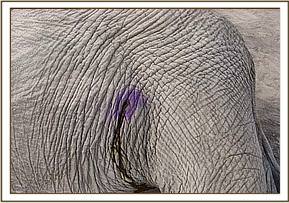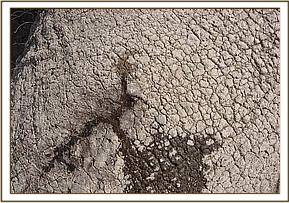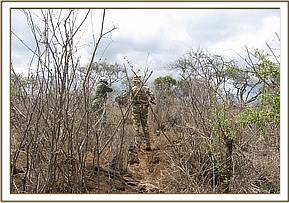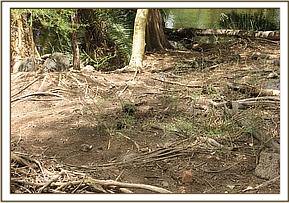Two of the cases attended to in early March were reported in the February report
Two of the cases attended to in early March were reported in the February report. These were two elephants in Amboseli from the same family attacked across the border in Tanzania. The condition of the ten-year-old female is said to have deteriorated after the treatment. The wound on the right carpal joint which had been given a guarded prognosis because of the involvement of the joint was said to have developed complications. The entire leg had become swollen and the animal was ambulating with difficulties. We attempted to search for it two weeks after the treatment for evaluation after we had been called for another injured elephant. However, we did not find it and neither had it been found at the time of preparing this report. It was said to have moved from the park towards the border probably in pursuit of the other injured adult female which was said to have crossed back to Tanzania. The female however was said to have made good progress and crossed the border to search for the other family members. 









Also treated at Olerai community land near Amboseli national park was an adult bull with a spear injury on the lower medial aspect of the left fore leg. The injury was however not serious and has a good prognosis. It wasn’t deep while the infection was mild. Darting was initially attempted on foot because of bad terrain. This however also proved difficult and the elephant was given time to move into a relatively better area where it was darted from a vehicle. 



We were also called to treat an 11 year old elephant at Rhino Valley in Tsavo West which had a very serious wound on the right shoulder. The animal was moving with a lot of difficulty and could hardly charge when darted on foot from a very close range. Examination revealed an extensive subcutaneous spread of massive infection and necrosis of soft tissues. Most of the muscles under and on the scapular bone were necrotic and sloughed off exposing the bone. Tissues on the ribs were also necrotic and the first three ribs were exposed too. An arrow head was retrieved deep within the injury. Body condition was poor. It is highly likely that the arrow head was poisoned in view of the extensive nature of the injury. No treatment was considered effective and the patient was put down to stop further suffering. The tusks were recovered and put under safe custody by the IPZ team.
Between the 19th and 20th March we tried to search for an elephant bull with a suspected arrow injury on the right abdomen in the community land adjacent to Amboseli NP at Kimana. This was also the time when we tried to search for the 10-year-old female described above to evaluate progress after treatment. The elephant was not found despite concerted efforts by three teams. At the time of preparing this report, there had been no further sighting of the elephant.
At Ziwani we were called to rescue an elephant calf that was frequently sighted by the local community outside the park. Reports also said that the elephant had a spear injury somewhere on the shoulder. We however found the calf too big (>4½ years old) and could not be taken into captivity for rehabilitation and eventual release back into the wild. The area is close to Ziwani River and has adequate forage and it can survive independently or join other herds that frequent the area. We could however not observe any physical injury from a distance and we resorted to immobilise it for close examination. This confirmed absence of any injury and the calf was consequently revived after it was given some antibiotic (8,000mg of 20% Oxytetracycline) intramuscularly. The body condition was good. 


In Tsavo West there have been deaths of hippos around Mzima springs on diverse dates in February and March 2009. To date, 8 hippos have been confirmed dead, 6 at Mzima springs and 2 at Kitani Bridge on the Tsavo River. Of the 6 that have so far died at Mzima springs, five have died near the springs and one about 5km away. The causes of the deaths have been attributed to starvation following the current dry spell which has affected availability of forage. The area around Mzima springs received scant rains in October/November last year which was inadequate to regenerate vegetation which was already withered after the rains in March/April 2008. 



The availability of forage has been aggravated by habitat destruction by other wildlife species which have been flocking the area to water and feed. Mzima springs is a critical watering point especially in the dry seasons. The hippos are forced to walk long distances in search of forage. This means that they are expending a lot of energy looking for forage and very little time remains for feeding. This has weakened several of them with the young and the old been mostly affected. 

Report by: Dr. David Ndeereh
The Mobile Veterinary Unit operated by The David Sheldrick Wildlife Trust working with The Kenyan Wildlife Service and funded by Vier Pfoten.